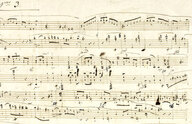



AF - Autograph fair-copy
| Date: | (1842) |
| Title: | Trois Mazourkas || No 3 |
| Dedication: | Monsieur Léon Szmitkowski |
While A1 of the Mazurka in G Major No. 1 is partially provisional and was almost certainly the first attempt to perform a copy intended as a Stichvorlage, its counterpart in this Mazurka certainly is not such an attempt. Dense notation without spaces between the great staves, which practically rules out the possibility of introducing changes, proves that the composer deemed the work on the piece to had been completed when he started writing, and did not see the need to take precautions against the possibility of further retouches. Taking into account the length and complexity of the Mazurka, he had to have a finished model of notation. It is confirmed by a small number of corrections, which are mainly autocorrections. It is unlikely that it was AI that served as the model, for despite a few corrections from the version of AI visible in AF, too substantial changes were introduced without leaving any traces – above all, the addition of 32 bars after b. 104 and the corresponding changes in b. 137-140. Such a chronology of the autographs of this Mazurka is also suggested by certain improvements of notation, visible in AF, e.g. slurring in b. 29-37 and 121-129.
On the other hand, there are places in which it is the notation of GE1, based on the lost autograph [AG], that seems to be more accurate, e.g. tied inner voice minims in b. 3-4 and analog., pedalling in b. 25-29 and analog. or richer performance indications in the ending of the piece (b. 173-180, 185, 189-191). In b. 77, 79, 85 and 87 it is GE1 that features an undoubtedly improved version – bass notes written an octave lower. Consequently, it is impossible – and pointless – to present both Stichvorlage autographs in chronological order in this Mazurka, since Chopin would almost certainly introduce corrections in both after he had finished them. This conclusion is confirmed by, e.g. the pedalling in identical b. 11-12 and 103-104:
- in the first pair of bars [AG] (→GE) features a
 at the end of b. 11, whereas in AF the mark in this place was crossed out and placed further, under the 3rd beat of b. 12;
at the end of b. 11, whereas in AF the mark in this place was crossed out and placed further, under the 3rd beat of b. 12; - in the second situation it was probably the other way round, AF features shorter pedal, whereas GE – longer.
The situation with the accents in b. 10 and 12 as well as in b. 102 and 104 is similar – the first time they are present in AF and absent in GE, the other time they are only in GE.
AF is not free from mistakes and inaccuracies, sometimes caused by extremely dense notation or inadvertence, e.g. oversight of d 1 in the chord in b. 28, broken R.H. slur in b. 134-137 or most probably erroneous L.H. slur in b. 137. The most serious mistake was the oversight of b. 81-88, which Chopin then added on a hand-written stave, committing a number of mistakes (see the notes to b. 81-88, 82-85, 84, 87 and 88).
1 in the chord in b. 28, broken R.H. slur in b. 134-137 or most probably erroneous L.H. slur in b. 137. The most serious mistake was the oversight of b. 81-88, which Chopin then added on a hand-written stave, committing a number of mistakes (see the notes to b. 81-88, 82-85, 84, 87 and 88).
AF plays a very important role in the editorial process of this Mazurka – to a certain extent, it allows us to control the text of the principal source (GE1), and in a number of places it is a source of at least equal alternative versions.
| Original in: | Pierpont Morgan Library, Nowy Jork |
| Shelf-mark: | C549.M476 (Mary Flager Cary Collection) |

